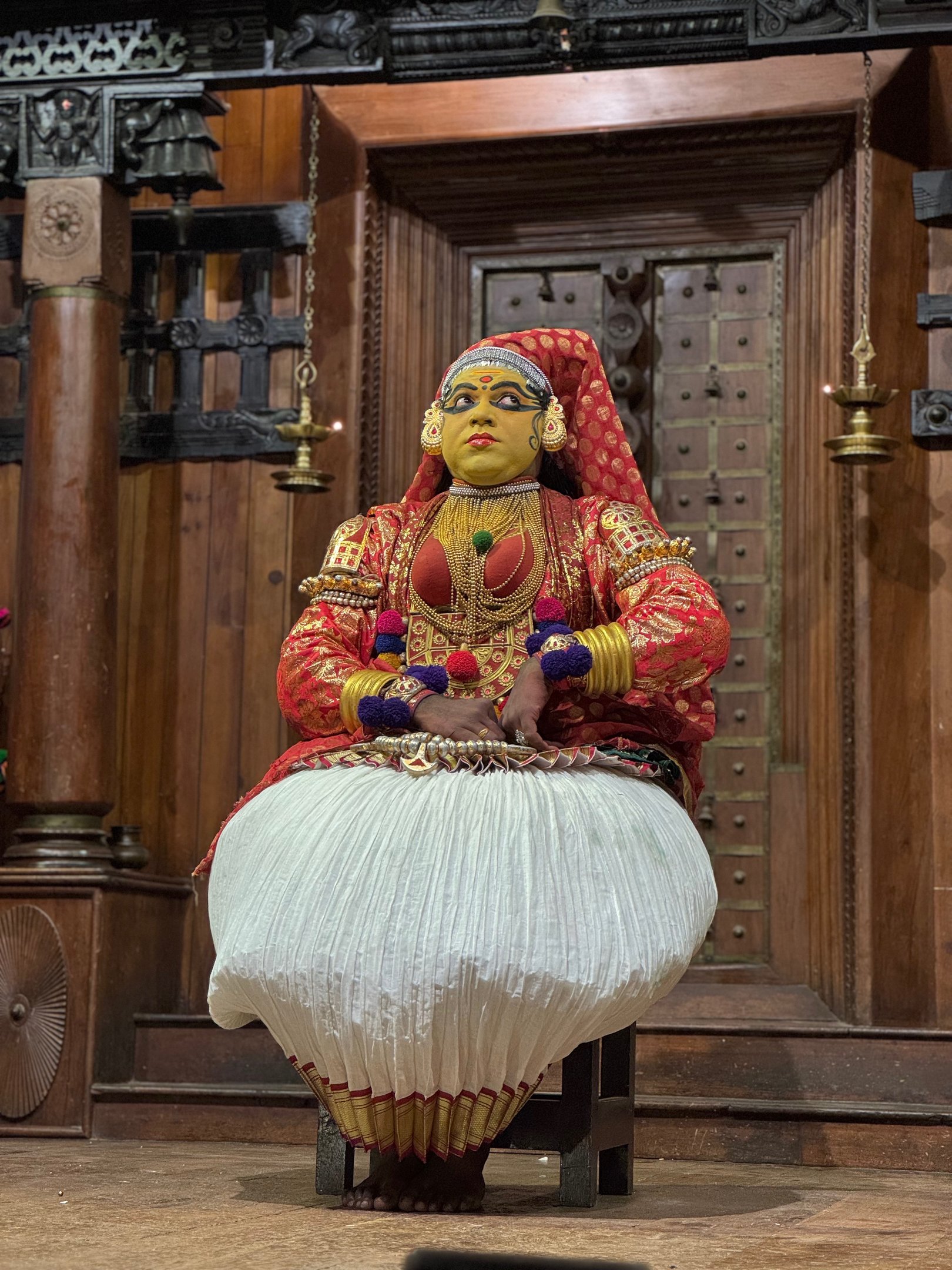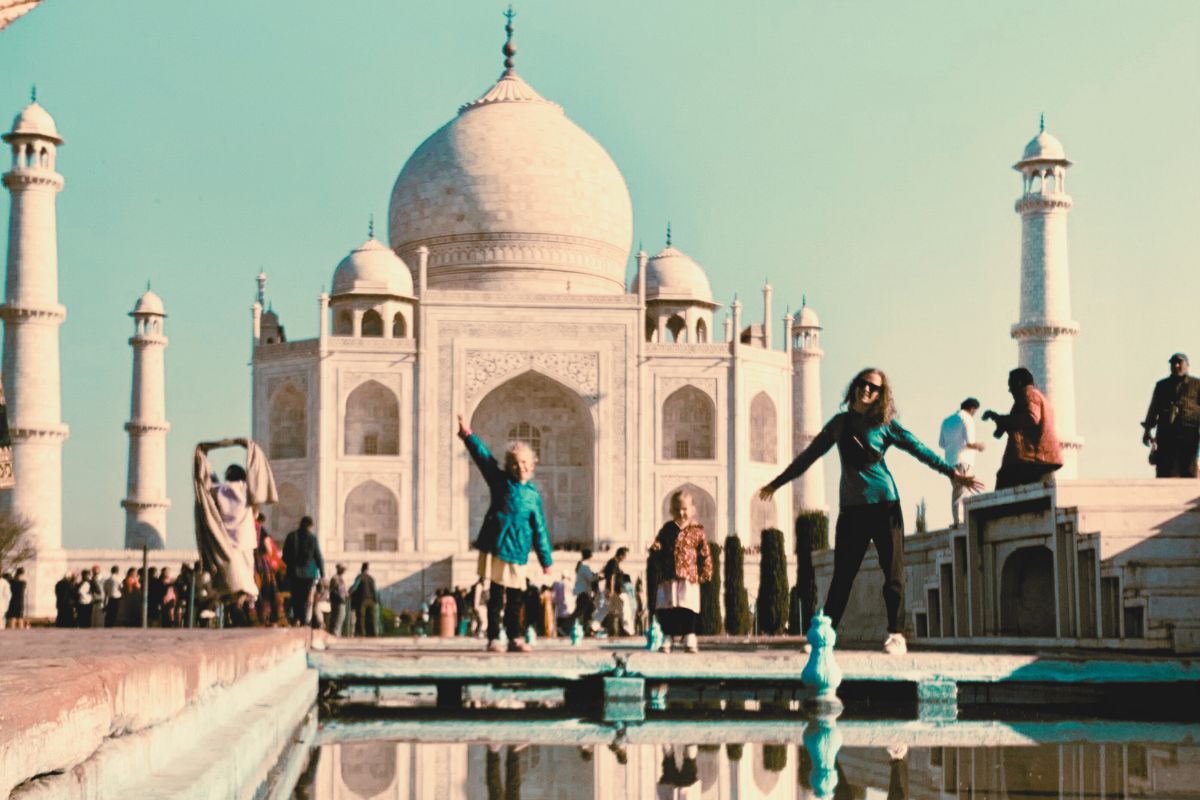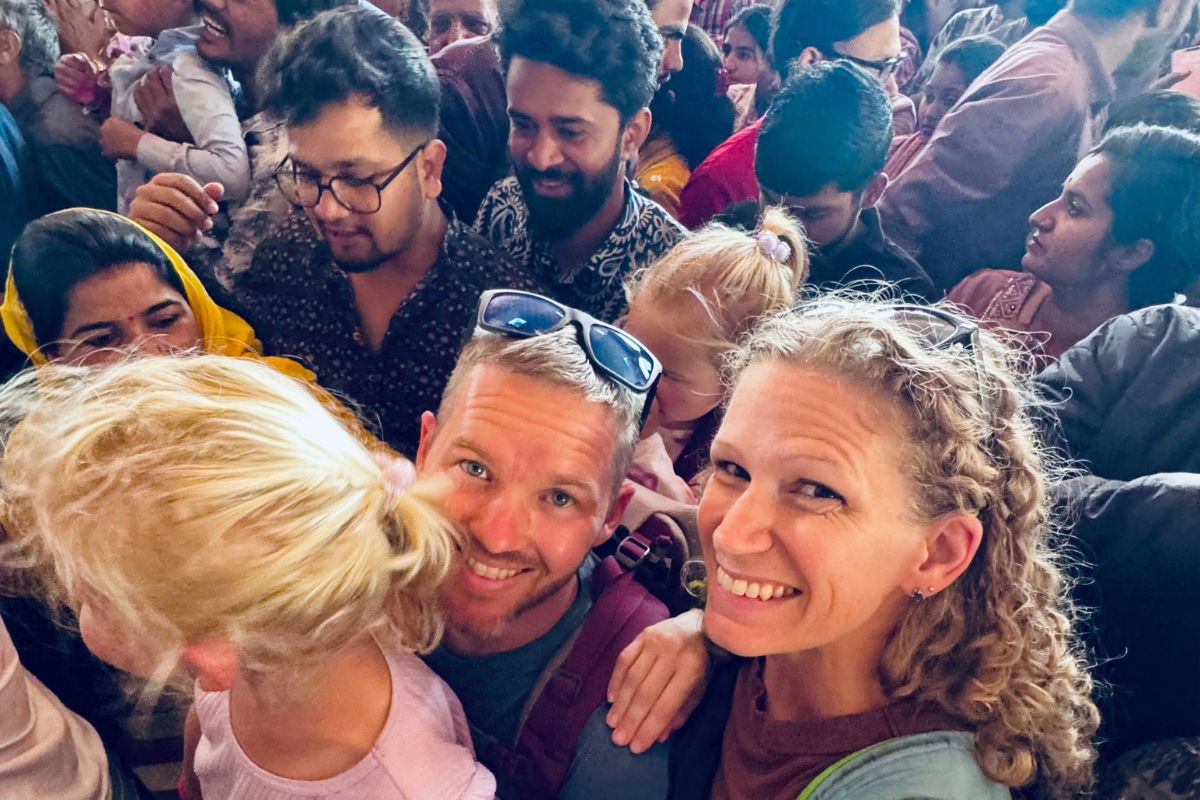Traveling with kids offers a unique opportunity to immerse them in diverse cultures and traditions. One such enriching experience awaits in Kerala, India, where the mesmerizing art form of Kathakali unfolds. This classical dance-drama captivates audiences with its vivid costumes, intricate makeup, and expressive storytelling, making it an unforgettable experience for families.
What is Kerala Kathakali and Why is it Special?
If you’re traveling to Kerala with your family, Kathakali is one experience you don’t want to miss. This 17th-century classical dance-drama is unlike anything you’ll find elsewhere. With vibrant costumes, intricate face makeup, expressive movements, and absolutely no spoken words, it’s a performance that completely captivates audiences—including kids!
Kathakali is a blend of theater, dance, music, and storytelling, bringing to life epic tales from Hindu mythology, mainly the Ramayana and Mahabharata. What makes it stand out is how the entire story is told through facial expressions, hand gestures (called “mudras”), and rhythmic movements, all set to traditional Kerala music.
Why is Kathakali Different from Other Indian Dance Forms?
Unlike many Indian dance styles that are more focused on rhythm and movement, Kathakali is deeply theatrical and visually striking. Here’s what makes it unique:
Makeup Time
-
Dramatic Makeup & Costumes: Performers wear elaborate makeup, called chutti, which transforms their faces into bold, colorful characters. Each color has meaning—green represents noble heroes, red symbolizes aggression, and black is for evil characters.
-
No Talking, Just Expressions: Instead of words, the actors rely entirely on expressions and hand gestures to convey emotions and storylines.
-
Live Musical Accompaniment: The performance is set to traditional music played on instruments like the chenda (drum), maddalam, cymbals, and the ela taalam (metal gong). Singers narrate parts of the story in Malayalam, but even without understanding the language, the emotions are clear.
-
Stories from Hindu Epics: Most Kathakali performances depict scenes from the Ramayana, Mahabharata, or other ancient texts, focusing on battles between good and evil, devotion, and courage.
Is Kathakali a family friendly experience?
One of the best parts about watching Kathakali with kids is how visually exciting and dramatic it is. The bright colors, exaggerated expressions, and larger-than-life costumes make it fun for children to watch, even if they don’t fully understand the storyline.
-
It’s Like a Live Cartoon: The way the actors use their faces and hands to tell the story is so expressive that even young kids can follow along—it’s almost like watching a silent movie!
-
Engaging and Interactive: Our venue let visitors arrive an hour early to watch the actors apply their makeup, which can be fascinating for kids.
-
Shortened Performances for Tourists: Traditional Kathakali shows can last several hours, but most performances in tourist-friendly areas are about an hour long, making them more suitable for families.
Great KV Kathakali Center Venue
Best Family-Friendly Kathakali Venue
If you’re visiting Kerala and want to see a kid-friendly Kathakali show, I highly recommend the Great K V Kathakali Center in Fort Kochi. Here’s why:
-
They offer a one-hour performance—a perfect length for kids.
-
You can arrive early (one hour before the show) to watch the actors apply their makeup—a fascinating behind-the-scenes look at how performers transform into their characters.
-
The venue was not crowded at all when we visited on a weekday, which makes it more comfortable for families.
-
There’s no strict seating arrangement, so you can sit up front for the best view, no obstructions for the kids.
📍 Show Timings: 2:00 PM and 5:00 PM daily
🎟️ Ticket Prices: ₹600 per adult (kids enter free)📞 Booking: You can buy tickets in person or reserve a spot via WhatsApp through the venue’s website.
Tips for Parents Taking Kids to a Kathakali Show
-
Arrive early – Watching the makeup application process can be just as exciting as the show itself.
-
Choose front-row seats – Kids will enjoy the best view of the performers’ expressions and costumes up close.
-
Prepare them beforehand – Let them know that there won’t be any talking during the performance—only music, dance, and facial expressions telling the story.
-
Keep them comfortable – Bring water and make sure they eat before the show to prevent mid-performance hunger.
-
Expect some movement – There’s no official intermission, but it’s okay to step out if needed.
Is Kathakali Too Intense for Some Kids?
Every child is different, so while most kids will find it exciting and fun, some might be sensitive to:
-
The loud drumming and music (which adds to the dramatic effect).
-
The intense facial expressions that can look exaggerated or even scary to some younger kids.
-
The slow pace of the storytelling, since Kathakali is a traditional art form and not a fast-moving action show.
If you think your child might feel overwhelmed, you can introduce them to Kathakali at home first by showing pictures or videos. Watching a short clip on YouTube can help prepare them for what to expect.
How to Explain the Storylines of Kerala Kathakali to Kids
Watching Kathakali with kids can be an incredible experience, but since there’s no talking—only facial expressions, hand gestures, and music—it helps to explain a few things beforehand so they can follow along. At our venue we were given a paper that outlined the story plot beforehand so we knew what was going to happen, which was helpful.
What is Kathakali About?
Most Kathakali performances bring to life stories from two major Hindu epics:
-
The Ramayana – A classic tale of Prince Rama, his wife Sita, and the demon king Ravana. It’s a battle of good versus evil, with magical creatures and heroic rescues.
-
The Mahabharata – A grand story of two royal families, the Pandavas and the Kauravas, locked in a battle over a kingdom. It’s filled with lessons on bravery, loyalty, and justice.
Kathakali often focuses on a small scene from one of these epics rather than the full story, making it easier for kids to absorb.
How to Explain Kathakali to Kids Before the Show
To help children connect with the performance, you can break it down in a way they understand:
-
Storytelling Without Words – Explain that the actors won’t be talking but will use their faces, hands, and movements to tell the story.
-
Facial Expressions Matter – The performers use BIG, exaggerated expressions to show emotions like happiness, anger, fear, and sadness.
-
Hand Gestures (Mudras) Tell the Story – Every gesture has a meaning—pointing might mean “look,” while a circular motion could mean “the sun.”
-
Male Performers Play All Roles – Even the female characters are played by men, which can be surprising to kids at first.
Colors Represent Characters – The makeup isn’t just for decoration; each color means something:
-
Green – Heroes and noble characters
-
Red – Angry or aggressive characters
-
Black – Demonic or villainous figures
-
White – Spiritual beings or gods
What Should Families Expect During a Kerala Kathakali Show?
If you’re planning to watch a Kathakali performance with your kids, knowing what to expect can help make the experience even better. Unlike most stage performances, Kathakali is a slow, expressive, and highly visual art form, and seeing it live is an unforgettable cultural experience.
Pre-Show Make Up
Arriving Early: Watch the Makeup Process
-
Come at least an hour before the show to watch the performers apply their elaborate makeup. This is one of the most fascinating parts of Kathakali!
-
The transformation takes time—actors spend about an hour applying layers of paint and intricate designs that symbolize their characters.
-
Kids will love seeing the step-by-step process of turning an ordinary face into a dramatic, colorful work of art.
Performance Duration and Structure
-
The main performance lasts about an hour, which is the perfect length for families with young kids.
-
Traditional Kathakali performances can go on for several hours, but the tourist-friendly versions are shorter and focus on the most engaging parts of the story.
-
No talking, just expressions, hand gestures, and music—the performers tell the story through movements and facial expressions, accompanied by drumming and singing.
Seating and Venue Setup
-
Most venues have unreserved seating, so it’s best to arrive early to grab front-row seats for the best view.
-
The theaters are usually small and intimate, so even if you don’t sit in the front, you’ll still get a great experience.
-
There’s no air conditioning in most venues, but they do have fans to keep the space comfortable.
Facilities and Comfort Tips
-
Restrooms are available inside or near the performance hall.
-
You can bring water to stay hydrated during the show.
-
While there’s no official intermission, you’re free to step outside if needed, especially if you have younger kids who might need a break.
The Fascinating Makeup and Costumes of Kerala Kathakali
One of the most striking and memorable parts of a Kathakali performance is the elaborate makeup and costumes. The level of detail that goes into transforming performers into larger-than-life characters is incredible, and seeing it up close is just as fascinating as the performance itself.
The Art of Kathakali Makeup (‘Chutti’)
Kathakali makeup, known as chutti, is an intricate process that can take over an hour to complete. Performers don’t just apply face paint—they build up layers of color and texture using a special paste made from rice flour and lime to create bold, three-dimensional features.
One of the most intense parts of Kathakali makeup is that some performers use natural eye irritants, like chundapoo (a type of seed), to turn their eyes bright red—adding to their dramatic look.
Eye Movements
Kathakali Costumes: Bold, Grand, and Iconic
Kathakali costumes are just as elaborate as the makeup, designed to make performers look majestic and larger than life.
-
Towering Headgear – Each character type has a distinct headpiece that adds height and grandeur.
-
Layered Skirts and Jackets – Performers wear brightly colored, voluminous skirts and heavily embroidered jackets, creating a striking stage presence.
-
Jewelry and Ornaments – Intricate necklaces, bracelets, and waistbands complete the look, making each character visually distinct.
Why the Makeup and Costumes Matter
In Kathakali, costume and makeup are not just for show—they are a crucial part of storytelling. Since there is no spoken dialogue, the bold colors, headgear, and facial designs help the audience instantly recognize the type of character on stage.
What Else Can Families Do in Kerala After Watching a Kathakali Show?
Once you’ve experienced the magic of Kathakali, there’s so much more to explore in Kerala with your family. Whether you’re looking for history, nature, or hands-on cultural experiences, Kerala has something for everyone. Here are some of the best family-friendly activities to add to your itinerary.
Wander Through the Historic Streets of Fort Kochi
Fort Kochi is one of the most fascinating places in Kerala for families to explore. With its mix of colonial history, artistic vibe, and local markets, there’s plenty to see and do.
-
See the Iconic Chinese Fishing Nets – These massive nets, believed to be introduced by Chinese traders centuries ago, are one of Kerala’s most famous sights. Kids will love watching fishermen operate them.
-
Visit the Santa Cruz Cathedral Basilica – One of the oldest churches in India, it has beautiful stained-glass windows and grand architecture.
-
Explore Jew Town and the Paradesi Synagogue – This historic area has narrow streets lined with antique shops and spice markets, giving a glimpse into Kerala’s Jewish heritage.
Take a Backwater Cruise in Alleppey
Kerala’s backwaters are one of the most unique attractions in India, and a boat ride is a must for families.
-
Houseboat Stays – If your family enjoys slow travel, spending a night on a houseboat lets you drift through lush canals, spot birds, and watch local life unfold along the water.
Visit the Tea Plantations in Munnar
Munnar’s rolling green hills and endless tea plantations make it one of the most beautiful places in Kerala. It’s a great destination for families who love nature and the outdoors.
-
Tour a Tea Factory – Learn how tea leaves are plucked, processed, and packed—and enjoy a tasting session at the end.
Explore the Hill Palace Museum in Tripunithura
If your family enjoys history, the Hill Palace Museum offers a look into Kerala’s royal past.
-
The museum was once the residence of the Maharaja of Kochi and now houses antique jewelry, paintings, and ancient artifacts.
-
The palace is surrounded by lush gardens and open spaces, making it a great place for kids to run around and explore after visiting the exhibits.
Visit a Spice Plantation
Kerala is known as the “Land of Spices,” and visiting a spice plantation is an educational and sensory experience for the whole family.
-
Learn how cardamom, pepper, cinnamon, and vanilla are grown.
-
Walk through fragrant gardens, where kids can touch and smell different plants.
-
Some plantations offer hands-on activities, like plucking fresh spices or tasting local honey.
Final Thoughts
Kerala is so much more than just its famous Kathakali performances. Whether your family prefers history, nature, or hands-on experiences, there’s something for everyone to enjoy. Taking the time to explore the local culture, scenic landscapes, and delicious food will make your trip to Kerala unforgettable!
More on the Blog:
Check out how much we spent in Kochi as a family of 4.
We experienced culture shock in India, but in a good way.










